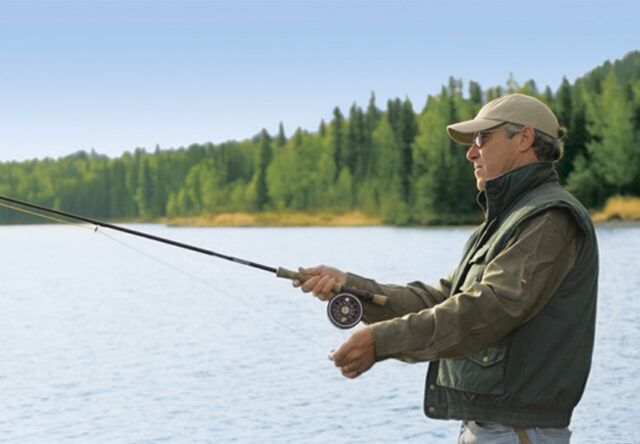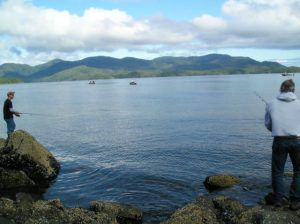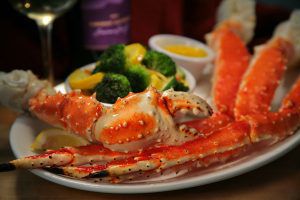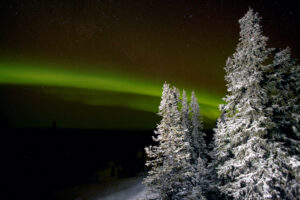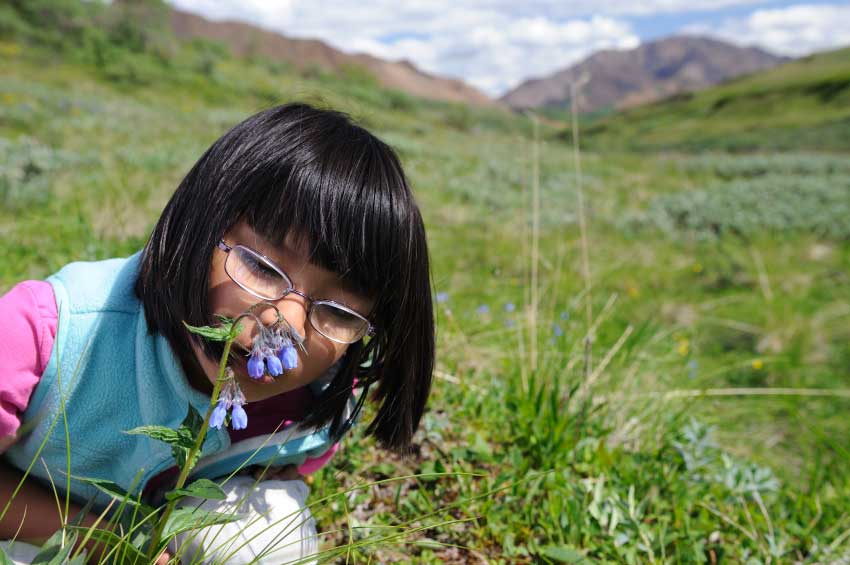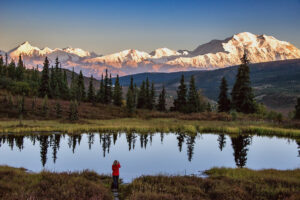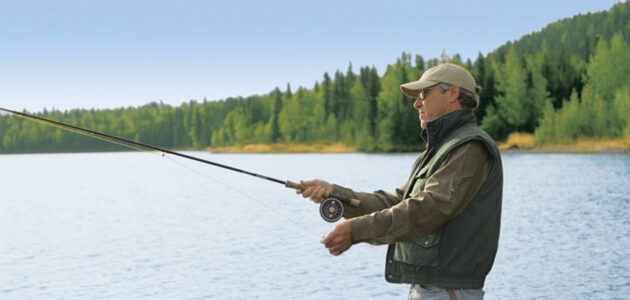
Salmon is among the local foods that Alaska is known for. Whether served formally by a master chef or prepared on a home barbecue with a dash of cooking sherry and lemon, salmon is as delicious as it is nutritious.
Eating salmon is only half of the fun! Visitors come from near and far to boast that they’ve successfully reeled in a prized fish. Alaska is home to five species of salmon. There are unique methods to catch each one. We hope this guide helps you catch a salmon that can be the star of your “big fish stories” for years to come.
Types of salmon in Alaska
King (chinook) salmon
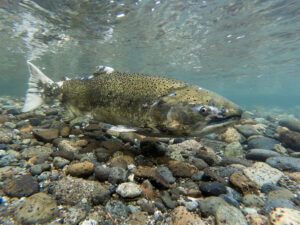
King salmon are the biggest of Alaska salmon. Their average weight is around 30 pounds, but the record is 126 pounds. The kings typically run in Alaska from May through July. Using a lure, bright-colored fly or salmon eggs are favored for freshwater king fishing. While possible, hooking a king from the riverbank is highly challenging due to its size and strength. It’s helpful to hire a guide to handle the logistics and ensure you are fishing in a prime spot. Although these fish are thrilling to catch, Alaska fishing regulations are complicated. King salmon require a specific license, so make sure that you review the current regulations before fishing (or your guide can help with this, too).
Red (sockeye) salmon
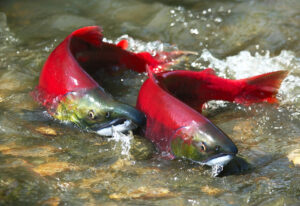
Sockeye salmon, or red salmon, are abundant in numbers, fun to catch, and delicious. Reds range from four to 15 pounds, placing them on the smaller end of salmon species. Despite their size, red salmon is favored for eating due to bright orange–red, flavorful meat. On the Kenai, the early run of red salmon is usually mid-June. Generally, the first run is smaller, and the fish are running much quicker than the late run. The late run is in late July, and at that time, the fish are often moving slower. Local anglers claim that during the peak of the run, anywhere on the lower or middle river is a “good spot.” For reds, it’s all about your presentation (some people swear by an empty hook with a piece of colored yarn), where you drop your hook (you want to be where the most fish are) and the weight of your line.
Silver (coho) salmon
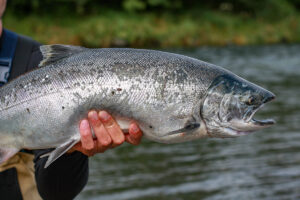
Silver, or coho, salmon are lighter colored and flavored salmon than the sockeye. They average eight to 12 pounds. Late July to September are prime times for catching silvers. When fishing for this species of salmon, there are a variety of methods that may prove effective. You can use a fly rod or eggs to catch this feisty fish. Anglers can try their luck fishing for silvers right in the heart of downtown Anchorage at Ship Creek — just a short walk from the Westmark Anchorage Hotel.
Pink (humpy) salmon
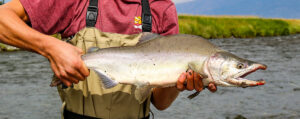
During the middle of August, the pink numbers are generally so high you would be hard-pressed not to catch a fish. Pink salmon meat is excellent salmon for smoking. Pinks are the smallest salmon species, weighing around three to five and a half pounds. You can catch pink salmon with spinners or flies. Because of its simplicity, catching pinks is a great way to get kids excited about salmon fishing!
Chum (dog) salmon
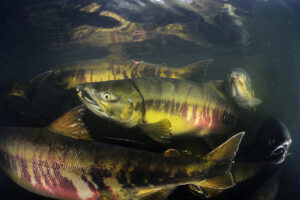
Chum salmon are the second largest of Alaska salmon. Adult chums average 10-13 pounds. Chums are abundant in many regions of the state but scarce north of Kotzebue Sound. Near Anchorage, you can find good chum fishing in the Little Susitna River. To catch chum, use a bobber and jig, twitch jig, or fly fishing!
Where to catch salmon
Kenai River
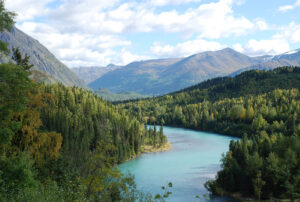
Among the many renowned destinations, Kenai River stands out as a captivating starting point for your fishing adventure. The Kenai River offers an unbeatable combination of breathtaking natural beauty and abundant salmon populations. Whether you’re an experienced angler seeking trophy-sized catches or a beginner looking to reel in your first salmon, Kenai River is the spot for an unforgettable salmon fishing experience.
If you want someone to take on the planning for you, guided fishing trips are a great option, guaranteeing you can sit back and enjoy the experience. Starting at the Kenai upper river, half-day and full-day tours are available.
Kasilof River
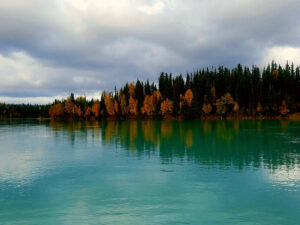
The Kasilof River is a neighbor to the Kenai River, both popular spots for fishing along the Kenai Peninsula. South of the Kenai, Kasilof tends to get less foot traffic and fewer tourists because it is a smaller river with a more prominent pink run than the Kenai. However, locals love the more secluded feel of fishing at Kasilof.
Russian River
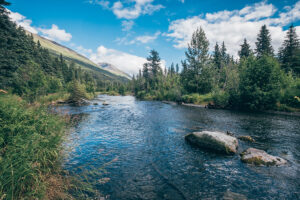
The Russian River is a paradise for salmon fishing enthusiasts. Locals call fishing here “combat fishing” due to the salmons’ determination and the shoulder-to-shoulder lineup of anglers. The Russian River is a fly-fishing area only, so anglers must use fly hooks. Some preferred flies are the bucktail streamer fly, the green lantern, the comet, or the shrimp pattern. We advise putting enough weight on the line so the fly bounces near the bottom of the river where the salmon like to swim. There are special restrictions on the weight placement, which can be found in the Alaska Sport Fishing Regulations Summary booklet. The beauty of the surrounding wilderness and the abundant fishing opportunities make it a special destination for anglers of all skill levels.
Brooks River
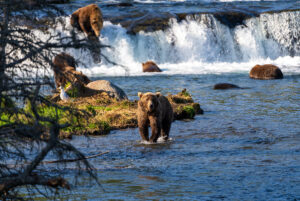
Nestled in the Katmai National Park and Preserve, Brooks River is a haven for nature enthusiasts and avid anglers seeking an unparalleled salmon fishing experience. This iconic river is home to the world-famous Brooks Falls, where salmon make impressive leaps upstream.
Visitors must remain vigilant because Katmai is prime bear country (thanks to all those salmon). If a bear approaches within 50 yards, all fishing must cease, and lines must be removed from the water. Fly fishing is the sole method allowed, and anglers must use unbaited, single-hook artificial flies. Preserving salmon populations is paramount, and most of the Brooks River maintains a catch-and-release policy. The only exception is downstream of the bridge, where anglers can retain one fish per person daily. The regulations at Brooks River are more complex than in some other locations, so stay up-to-date through the Alaska Fish & Game or National Park Service websites.
Ship Creek
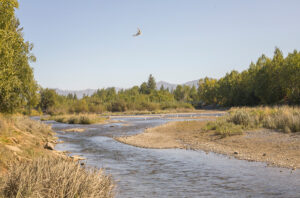
Ship Creek is the perfect choice for those looking for a salmon fishing experience right in the heart of Anchorage. Just a stone’s throw from downtown, this urban fishing spot offers the chance to catch king salmon during their annual runs. Ship Creek is an accessible and convenient option for locals and visitors, providing a unique fishing experience in an urban setting.
Seward
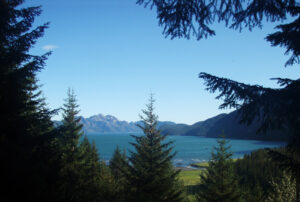
Located on the breathtaking Resurrection Bay, Seward is a haven for nature enthusiasts and avid anglers, boasting an array of fishing opportunities. The nearby waters provide access to various salmon species, including king salmon, sockeye salmon, and silver salmon. With its picturesque surroundings and easy access to prime fishing grounds, Seward is a fantastic destination for recreational and sport anglers.
Shore anglers can try their luck at various hotspots, such as the Lowell Creek waterfall, the Seward Lagoon outfall culverts, and the salt waters in front of the Fourth of July Creek. These locations offer exciting opportunities for reeling in silvers from the comfort of the shoreline, allowing anglers to immerse themselves in the breathtaking scenery while chasing their prized catch.
Talkeetna
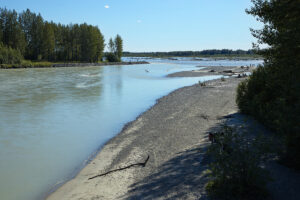
In the heart of the Matanuska-Susitna Valley, the charming town of Talkeetna offers remarkable salmon fishing opportunities. Popular spots like the Deshka River, Alexander Creek, and Clear Creek near Talkeetna are worth exploring for various fishing options, each with its own set of regulations. Talkeetna sportfishing excursions are available to enhance your fishing experience.
Homer
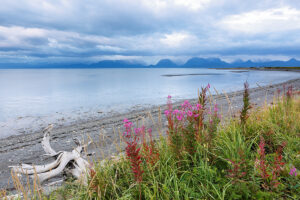
Known as the “Halibut Fishing Capital of the World,” Homer is also a fantastic destination for salmon fishing. The nearby waters of Kachemak Bay and Cook Inlet offer excellent opportunities to catch king salmon, sockeye salmon, and silver salmon. A notable highlight is the Nick Dudiak Fishing Lagoon. This stocked king salmon fishery opens in early June, offering a pristine angling experience. At the southern tip of the Homer Spit lies the mudflats and Mud Bay. It is unwise to walk in the mud, but anglers can stand along the sandy or gravelly shores during high tide to reel in pinks or silvers. With its stunning coastal scenery and thriving fishing community, Homer is a must-visit destination for any angler seeking a memorable salmon fishing experience.
Alaska’s rivers and coastal waters offer an unmatched salmon fishing experience, each location providing unique charm and opportunities. Whether you choose the world-famous Kenai River, treasures like Ship Creek and the Russian River, or the scenic towns of Talkeetna, Homer, and Seward, you’re guaranteed an adventure filled with thrilling catches and unforgettable memories. So, pack your gear, immerse yourself in Alaska’s natural wonders, and get ready to reel in the salmon of a lifetime. Happy fishing!
Frequently asked questions
Do I need a fishing license?
Nonresidents above the age of 16 and residents above the age of 18 always need a fishing license (kids are off the hook)! You must have a fishing license from Alaska Fish and Game for all fishing in Alaska. For king salmon, you usually need a king salmon stamp, and sometimes you must record it on a harvest card, so look up the regulations for the location you are fishing.
How do I purchase an Alaska fishing license?
You can buy a fishing license online from ADFG or at many local bait shops, gas stations and grocery stores.
How much does an Alaska fishing license cost?
Nonresident 16 Years and Older:
- Nonresident One Day Sport Fishing License $25.
- Nonresident One Day King Salmon Stamp $15.
- Nonresident Three-Day Sport Fishing License $45.
- Nonresident Three-Day King Salmon Stamp $30.
- Nonresident Seven-Day Sport Fishing License $70.
- Nonresident Seven-Day King Salmon Stamp $45.
- Nonresident 14-Day Sport Fishing License $105.
- Nonresident 14-Day King Salmon Stamp $75.
- Nonresident Annual Sport Fishing License $145.
- Nonresident Annual King Salmon Stamp $100.
Resident 18 years and older:
- Resident Annual Sport Fishing License $29
- Resident Annual King Salmon Stamp $10.
- Resident Duplicate License $5.
- Resident Duplicate King Salmon Stamp $5.
Can I keep my catch?
This depends on the location. Many locations have a fish limit per day; some areas are catch and release only. The Department of Fish and Game website will have regulations on limits and restrictions for catching and keeping your fish.
Where do I begin planning an Alaska fishing trip?
We would start by figuring out your goals for the journey — catching as many fish as possible, having a memorable experience, kid-friendly fishing, seeing lots of places in Alaska, catching the biggest fish, etc. From there, you can focus on different locations, different species of salmon, which month is the peak of the run, and whether a guided trip is the best fit for you.


